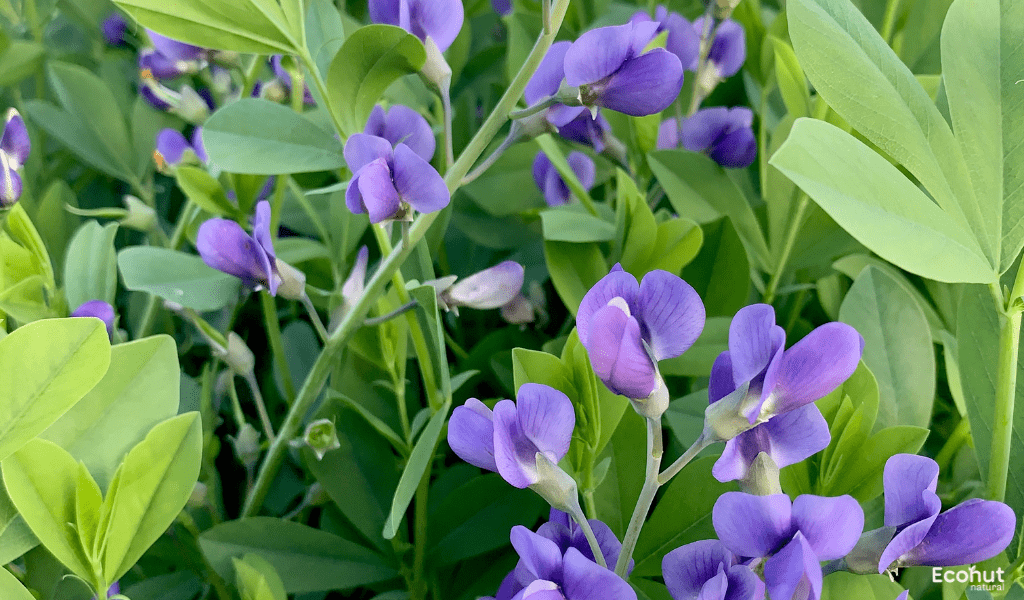Wild Indigo (Baptisia Australis) it’s a flowering perennial plant. Slow-growing wild indigo forms clumps with deep, sprawling roots. Once it begins to develop, it shouldn’t be disturbed. Although wild indigo can be cultivated from seed, maturity takes several years. It becomes a shrubby look after flowering.
Wild Indigo Timely trimming is necessary to keep its rounded shape. It has both sexual and asexual reproduction. In gardens, loamy, fertile soil is ideal for the growth of wild indigo. This plant never experiences significant disease or pest issues. Support may be necessary for taller plants of this species, especially if they are growing in a partially shaded area.
Description
This plant is erect and can reach a height of three to four feet. This plant emerges from the rhizomatic network and grows in rich forests. The deep, branching roots of wild indigo aid in its resistance to drought. Its branches are smooth and hairless. When sap released from it comes into contact with air, it turns blue.
Botanical Name:
Baptisia Australis
Family:
Fabaceae
Leaves:
The trifoliate (made up of three leaflets) leaves of baptismisia are placed sporadically along the stems. Leaflet forms range from almost round oval to thin oblong. The color of baptismisia leaves can range from a delicate, felted gray-green to a vivid yellow-green or blue-green.
Flowers:
Early summer brings flower spikes. Short, erect terminal racemes with pea-like blooms that range in color from pale blue to deep violet emerge at the apex.
Stems:
Erect, robust, and glabrous (hairless) wide branches around midway up the stem
Fruits:
Pods that are inflated and eventually turn bluish-black oblong in shape with a tip that is pointy. The kidney-shaped, loose, yellowish-brown seeds are inside these pods. As seeds ripen, their stems get gray and split, allowing the wind to disperse the seeds.
Habitat:
Although blue wild indigo is endemic to eastern North America, its occurrences in New England are thought to be introduced. It is located close to homes, on riverbanks, and on riparian terraces, and it most likely symbolizes getaways from agriculture.
Parts Used:
- Roots
Common names
Blue false indigo, wild indigo, yellow false indigo, rattle weed, rattle bush, and horsefly weed.
Scientific Classification
| Kingdom | Plantae |
| Phylum | Angiosperms |
| Subphylum | Eudicots |
| Class | Rosids |
| Order | Fabales |
| Family | Fabaceae |
| Genus | Baptisia |
| Species | B.australis |
Wild Indigo (Baptisia Australis) Uses
- This plant possesses antioxidant properties that help the body get rid of oxidants and free radicals. It fortifies the body’s defenses against illnesses and infections and raises immunity.
- When applied externally to the affected area, its anti-inflammatory poultice helps to reduce pain, redness, and swelling.
- In addition to helping to ease other symptoms including body aches and congestion in certain body regions, it can be used to lower fever.
- This herb’s powder is used to treat eczema and other skin diseases that cause irritation.
- It is used as the remedy Baptisia tinctoria in homeopathy. It is well known around the world as a typhoid treatment. It is useful in treating typhoid fever symptoms such as severe prostration, headache, sore throat, bodily pain, and impaired vision. Numerous additional illnesses, such as sepsis or dangerous infections, are also treated with it.
Wild Indigo (Baptisia Australis) Benefits
Common Cold:
Though this might seem more appropriately classified under the immune system, baptism has been demonstrated to have potent antiviral and antiviral properties against influenza and the common cold. You might want to consider adding additional herbal supplementation if you have a weakened immune system and get sick often.
Skin Health:
Baptisia can be used to reduce inflammation in relation to other skin issues, such as irritation, age spots, wrinkles, and blemishes.
Respiratory Health:
Baptisia can function as an expectorant, removing mucus and phlegm that can build up in your respiratory tracts and attract bacteria and viruses, if you have a sore throat or an irritated respiratory system, which frequently occurs with disorders like bronchitis or the flu. Baptisia’s anti-inflammatory properties can also lessen tract irritation and hasten the recovery from respiratory illnesses.
Pain Relief:
Apply baptisia topically to any area of your body experiencing concentrated pain, and the herb’s analgesic effects will take over. This was a typical procedure in ancient medicine for women who were sensitive in that area, specifically the nipples. Those who have wounds, pain following surgery, or signs of arthritis can also utilize this.
Wild Indigo (Baptisia Australis) Side Effects
Ingestion Dangers:
Wild indigo (Baptisia Australis) taken orally is regarded as likely unsafe, particularly when taken in large amounts or for prolonged periods of time. Numerous unpleasant gastrointestinal symptoms, including cramps, diarrhea, vomiting, and other gut disorders, may result from this.
Pregnancy and Breastfeeding:
It’s imperative to completely avoid wild indigo during pregnancy and breastfeeding due to possible safety risks for both mother and child.
Stomach and Intestinal Issues:
As was already noted, excessive dosages may irritate the digestive system and result in cramping, vomiting, and diarrhea.
Also Read: Neem, Indian Lilac (Azadirachta indica) – Properties, Uses, Dosage, Benefits & Side Effects
Conclusion
Indigo wild is an herb. To create medicine, the root is utilized. Infections such as typhoid, malaria, scarlet fever, lymph node infections, swine flu, diphtheria, and other upper respiratory tract diseases can all be treated with wild indigo.
FAQS
What advantages does wild indigo offer?
Indigo wild is an herb. To create medicine, the root is utilized. Infections such as typhoid, malaria, scarlet fever, lymph node infections, swine flu, diphtheria, and other upper respiratory tract diseases can all be treated with wild indigo.
What is Baptisia australis used for?
Native Americans employed B. australis medicinally as an eyewash, a purgative, and a treatment for toothaches and nausea.
What adverse consequences does baptism root have?
Nausea, anorexia, hypersalivation, tachypnea, tachycardia, and respiratory paralysis are possible side effects.

